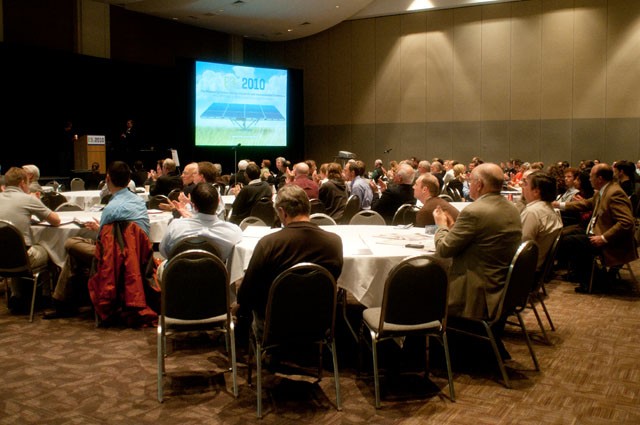Wednesday was a typical winter day in St. Paul: cold and windy.
While some might find the conditions unpleasant, close to 200 people gathered at the St. Paul RiverCentre to share ideas about how to use such conditions to harness energy.
The event was part of the University of Minnesota Institute on the EnvironmentâÄôs E3 âÄî Energy, Economic and Environmental âÄî Conference, which focused on combining innovative technologies, policies and environmental benefits to find new opportunities in the renewable energy sector.
Presenters at the event spoke about the UniversityâÄôs unique ability, and responsibility, to help the U.S. convert 20 percent of its total energy usage to wind energy by the year 2030 âÄî a goal set by the U.S. Department of Energy.
As part of the American Recovery and Reinvestment Act of 2009, the University won approximately $8 million of a $24 million grant from the DOE to develop wind energy technologies.
“Saudi Arabia is to oil as the U.S. is to wind, and Minnesota has a big piece of it,” said Megan McCluer, senior adviser for Wind Power technologies at the DOE.
“[Receiving the grant] is a huge honor and a huge burden,” she said. “ItâÄôs taxpayer money and you have to show itâÄôs going to be a benefit to the community.”
Since receiving the grant, the UniversityâÄôs St. Anthony Falls Laboratory (SAFL) has taken the reins of the current wind energy project.
At the conference, civil engineering professor Roger Arndt went over the details of the grant-funded 2.5-megawatt wind turbine at the lab. The ability to develop and test the turbine in a full-scale laboratory such as SAFL will help the U.S. reach 20 percent, according to the 2010 annual report for the instituteâÄôs Initiative for Renewable Energy and the Environment.
Experts working in wind energy research agreed that several obstacles must be cleared in order to meet such a dramatic goal.
One of the most difficult hurdles is to gain public acceptance, McCluer said.
Many communities do not like the idea of wind turbines because of their size, McCluer said. The blades of a typical horizontal turbine are approximately 90 yards long âÄî almost the size of a football field.
Despite the size, such technology is ready to be implemented on a smaller scale, said Jose Zayas, senior manager of renewable energy technologies at Sandia National Laboratories.
“A lot of research is being done today at research facilities and universities that is truly applicable to small communities,” he said.
Another hurdle to clear is the cost-effectiveness of wind energy. Almost all presenters agreed that factors such as capital costs, reliability enhancements and the ability to pay for improvements are all areas of research needing more development.
Finally, making advances in weather forecasting is essential to developing new technologies, WindLogics CEO Mark Ahlstrom said.
Despite such obstacles, many believe achieving the goal is a possibility, as long as industry professionals, researchers and experts come together.
“We are ahead of what is needed to get to 20 percent by 2030,” Zayas said.
“LetâÄôs not be like the sixth graders on the soccer team all chasing the ball all the time,” Ahlstrom said. “LetâÄôs play our positions and do it right.

















